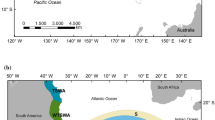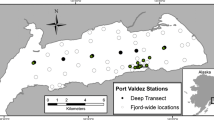Abstract
As the primary producers, acritarchs represent the base of the food chain in the Paleozoic marine ecosystem which links with the evolution of acritarchs. Based on high precision quantitative research, much information about Paleozoic marine ecosystem is provided. A quantitative analysis of Early-Middle Ordovician acritarch diversity changes in the Meitan Formation, Honghuayuan section, Tongzi, Guizhou is made and the the acritarch diversity curves are compared with sea level curves. We found that acritarch diversity changes were related to sea level changes during the Early-Middle Ordovician. Whereas sea level rose, and acritarch diversity also increased. An inshore-offshore model of acritarchs best explains the relative abundance changes of some acritarch taxa in relation to sea level changes.
Similar content being viewed by others
References
Servais, T., Li, J., Stricanne, L. et al., Acritarchs, in The Great Ordovician Biodiversification Event (eds. Webby, B. D., Paris, F., Droser, M. L. et al.), New York: Columbia University Press, 2004, 348–360.
Dale, B., Dinoflagellate cyst ecology: Modeling and geological application, in Palynology: Principles and Applications, Vol 3 (eds. Jansonius, J., McGregor, D. C.), Salt Lake City, Utah: American Association of Stratigraphic Palynologists Foundation, Publishers Press, 1996, 1249–1257.
Wall, D., Dale, B., Lohmann, G. P. et al., The environmental distribution of dinoflagellate cystes in mordern marine sediments from regions in the north and south Atlantic oceans and adjacent seas, Marine Micropaleont., 1977, 2(2): 121–200.
Song, Y. C., Vegetation Ecology (in Chinese), Shanghai: East China Normal University Press, 2001, 1–673.
Whittaker, R. H., Evolution and measurement of species diversity, Taxon, 1972, 21: 213–251.
Magurran, A. E., Ecoligical Diversity and Its Measurement, New Jersey: Princerton University Press, 1988, 1–179.
Webby, B. D., Cooper, R. A., Bergström, S. M. et al., Stratigraphic framework and Time Slices, in The Great Ordovician Biodiversification Event (eds. Webby, B. D., Paris, F., Droser, M. L. et al.), New York: Columbia University Press, 2004, 41–47.
Jacobson, S. R., Acritarchs as paleoenvironmental indicators in Middle and Upper Ordovician rocks from Kentucky, Ohio and New York, Journal of Paleontology, 1979, 53(5): 1197–1212.
Dorning, K. J., Silurian acritarch distribution in the Ludlovian shelf sea of South Wales and the Welsh borderland, in Microfossils from Recent and Fossil Shelf Seas (eds. Neale, J., Brasier, M.), Chichester: Ellis Horwood Ltd., 1981, 31–36.
Li, J., Servais, T., Yan, K. et al., A nearshore-offshore trend in the acritarch distribution of the Early-Middle Ordovician of the Yangtze Platform, S-China, Review of Palaeonbotany and Palynology, 2004, 130(1–4): 141–161.
Du, Y. S., Tong, J. N., Paleontology and historical geology (in Chinese), Wuhan: China University of Geoscience Press, 1998, 1–212.
Vecoli, M., Palaeoenvironmental interpretation of microphytoplankton diversity trends in the Cambrian-Ordovician of the northern Sahara Platform, Palaeogeography, Palaeoclimatology, Palaeoecology, 2000, 160: 329–346.
Tongiorgi, M., Yin, L. M., Di Milia, A., Lower Yushangian to Zhjiangian palynology of the Yangtze Gorges area (Daping and Huanghuaxhang sections), Hubei Province, South China, Palaeonotographica Abt. B, 2003, 266: 1–160.
Bambach, P. K., Seafood through time: changes in biomass, energetics, and productivity in the marine ecosystem, Paleobiology, 1993, 19(3): 372–397.
Sprangers, M., Dammers, N., Brinkhuis, H. et al., Mordern organic-walled dinoflagellate cyst distribution offshore NW Iberia; tracing the upwelling system, Review of Palaeobotany and Palynology, 2004, 128: 97–106.
Molles, M. C., Ecology: Concepts and Applications, Beijing: Science Press. 2000, 1–509.
Chen, X., Rong, J. Y., Zhou, Z. Y., Ordovician Biostratigraphy of China, in Biostratigraphy of China (eds. Zhang, W. T., Chen, P. J., Palmor, A. R.), Beijing: Science Press, 2003, 121–171.
Chen, X., Graptolite depth zonation, Acta Palaeontologica Sinica (in Chinese with English abstract), 1990, 29(5): 507–526.
Xu, W. H., Depth zonation of Arenigian acritarchs in South China, Chinese Science Bulletin (in Chinese), 1996, 42(2): 156–159.
Vecoli, M., Le Herisse, A., Biostratigraphy, taxonomic diversity and patterns of morphological evolution of Ordovician acritarchs (organic-walled microphytoplankton) from the northern Gondwana margin in relation to palaeoclimatic and palaeogeographic changes, Earth-Science Reviews, 2004, 67: 267–311.
Author information
Authors and Affiliations
Corresponding author
About this article
Cite this article
Yan, K., Li, J. & Liu, J. Biodiversity of Early-Middle Ordovician acritarchs and sea level changes in South China. Chin.Sci.Bull. 50, 2362–2368 (2005). https://doi.org/10.1007/BF03183748
Received:
Accepted:
Issue Date:
DOI: https://doi.org/10.1007/BF03183748




